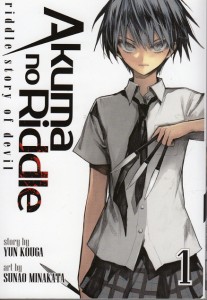Manga Review: Akuma no Riddle Volume 1 story by Yun Kouga, art by Sunao Minakata
Azuma Tokaku is the star student at Private Academy 17, secretly a school for assassins. As such, she’s being temporarily transferred to Myojo Private School, to participate in Class Black. Supposedly, Class Black is a game disguised as an ordinary homeroom class–twelve assassins compete to see which one of them can kill the thirteenth student.
The target is Haru Ichinose, a bubbly girl who doesn’t seem to have a care in the world. But we soon have hints that her past is dark indeed, and she’s much harder to kill than she appears. Azuma begins to have second thoughts about her mission…perhaps she should be protecting Haru instead?
This manga (“Devil’s Riddle”) has been adapted into an anime series as well. (I am told the anime compresses the series and cuts out several subplots.) The author’s notes mention a “social game” but it’s not clear if this series was adapted from that or vice-versa.
In the tradition of dystopian YA, it is readily apparent that the teenage assassins have not been told the entire truth about what’s going on, and some of what the adults have led them to believe is completely false. Azuma’s teacher at Private Academy 17 tells the reader as much, and looks forward to her figuring that out. Most of the characters have very dark backstories, most only hinted at in this volume. (Haru’s body is covered in nasty scars, and “Tokaku” means “rabbit’s horn”, aka “a thing that does not exist” like a jackalope.)
Most of the first volume is given over to brief introductions to the characters; there are thirteen girls in Class Black, a homeroom teacher who appears to be oblivious to what’s really going on, Azuma’s teacher, and the mysterious person who set up Class Black. Azuma and Haru get the most characterization as “trying hard to be an emotionless professional” and “overly cute girl who refers to herself in the third person.”
The art is decent but relies heavily on hairstyles and uniforms to distinguish the characters. There’s a couple of fanservicey scenes in aid of the plotline.
The book’s primary weakness from my point of view is that it seems overly calculated. Each of the young women is designed to fit into a particular “appeal category” (the big-breasted one, the one with glasses, the one that looks underage, etc.) and I would not be surprised if this was originally published in a magazine with a primarily male reader demographic. Also, the premise kind of unsuspends my disbelief. Yes, I can accept for the sake of the concept one small private school that trains assassins, but here we have twelve teenage girls who come from twelve different schools and are all trained assassins. Plus we’re given to understand that Class Black has happened at least twice before without the outside world noticing.
I do not think I will be picking up a second volume, but if teenage female assassins are your thing, and the plausibility issues aren’t a dealbreaker for you, you might enjoy this.

